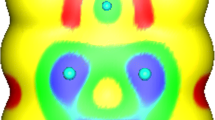Abstract
Based on the density functional theory and partitioning the molecular electron density ρ (r) into atomic electronic densities and bond electronic densities, the expressions of the total molecular energy and the “effective electronegativity” of an atom or a bond in a molecule are obtained. The atom-bond electronegativity equalization model is then proposed for the direct calculation of the total molecular energy and the charge distribution of large molecules. Practical calculations show that the atom-bond electronegativity equalization model can reproduce the correspondingab initio values of the total molecular energies and charge distributions for a series of large molecules with a very satisfactory accuracy.
Similar content being viewed by others
References
Mortier, W. J., Ghosh, S. K., Shankar, S., Electronegativity equalization method for the calculation of atomic charges in molecules,J. Am. Chem. Soc., 1986, 108: 4315.
Baekelandt, B. G., Mortier, W. J., Lievens, J. L. et al., Probing the reactivity of different sites within a molecule or solid by direct computation of the atomic sensitivities via an extension of the electronegativity equalization method,J. Am. Chem. Soc., 1991, 113: 6730.
York, D. M., Yang, W., A chemical potential equalization method for molecular simulations,J. Chem. Phys., 1996, 104: 159.
Ghosh, S. K., Electronegativity, hardness and a semiempirical density functional theory of chemical binding,Inter. J. Quan. Chem., 1994, 49: 239.
Bergmann, D., Hinze, J., Electronegativity and molecular properties,Angew. Chem. Int. Ed. EngL., 1996, 35: 150.
Coislowski, J., Stenfanov, B. B., Electron flow and electronegativity equalization in the process of bond formation,J. Chem. Phys., 1993, 99: 5151.
Coislowski, J., Martinov, M., Spin-resolved analysis of electronegativity equalization and electron flow in molecules,J. Chem. Phys., 1995, 102: 7499.
Park, J. M., Kwon, O. Y., No, K. T. et al., Determination of net atomic charges using a modified partial equalization of orbital electronegativity method (5),J. Comp. Chem., 1995, 16: 1011.
Yang Zhongzhi, Shen Erzhong, Direct calculation of atomic charges in a molecule via elctronegativity equalization principle,Science in China, Ser. B, 1995, 38: 521.
Yang Zhongzhi, Shen Erzhong, Direct calculation of group electronegativity and atomic charges in a group,Science in China, Ser. B, 1996, 39: 20.
Shen Erzhong, Yang Zhongzhi, Direct calculation of total molecular energy,Acta Chimica Sinica (in Chinese), 1996, 54: 152.
Pauling, L.,The Nature of the Chemical Bond, 3rd ed., Ithaca: Cornel University Press, 1960.
Sen, K. D., Jorgensen, C. K.,Electronegativity, New York, Heidelberg: Springer-Verlag, 1987, 66: 1–25, 125–143.
Parr, R. G., Yang, W.,Density Functional Theory of Atoms and Molecules, New York: Oxford Univ. Press, 1989.
Parr, R. G., Dongelly, R. A., Levy, R. A. et al., Electronegativity: density functional theory,J. Chem. Phys., 1978, 68: 3801.
Dongelly, R. A., Parr, R. G., Elementary properties of an energy functional of the first-order reduced density matrix,J. Chem.Phys., 1978, 69: 4431.
Politzer, P., Weinstein, H., Some relations between electronic distribution and electronegativity,J. Chem. Phys., 1979, 71: 4218.
Sanderson, R. T.,Chemical Bonds and Bond Energy, New York: Academic Press, 1976.
Reed, A. E., Weinstock, R. B., Weinhold, F., Natural population analysis,J. Chem. Phys., 1985, 83: 734.
Huzinaga, S., Sakai, Y., Miyoshi, E. et al., Extended Mulliken electron population analysis,J. Chem. Phys., 1990, 93: 3319.
Author information
Authors and Affiliations
Additional information
Project supported by the National Natural Science Foundation of China (Grant No. 29573106).
Rights and permissions
About this article
Cite this article
Yang, Z., Wang, C. & Tang, A. Molecular electronegativity in density functional theory (VI). Sc. China Ser. B-Chem. 41, 331–336 (1998). https://doi.org/10.1007/BF02879716
Received:
Issue Date:
DOI: https://doi.org/10.1007/BF02879716




